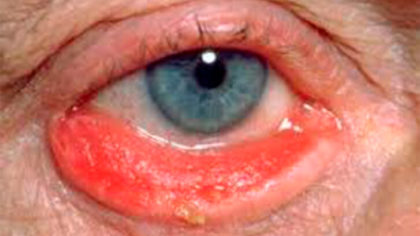Palpebral ectropion is the eversion of the lower eyelid that turns outward.
To have good eye health, it is essential that the eyelids are in contact with the eyeball. There must be a correct lubrication of the conjunctival and corneal surface and a proper visual quality.
If this is not the case, the patient manifests multiple signs and symptoms that can range from mild to disabling, among which are the following:
Corneal injury from exposure or keratitis; conjunctival hyperemia or red eye; thickening of the conjunctiva and keratinization due to chronic dryness and , continuous tearing or epiphora, since it is not possible for the tear to be collected through the lower tear hole, because in many cases there is also an eversion of the tear point.
The most common cause of ectropion is associated with aging. Over time, there is a laxity of the muscle tissue that surrounds the eye, its action of contracting and impelling the tear in each blink being ineffective. This causes a sensation similar to having a grit in the eye and even pain if it is very advanced, as well as chronic tearing or epiphora.
Other causes of ectropion are: paralysis of the facial nerve, scars due to burns, surgery or trauma, mechanical (for example by large lower fat bags under eyes or eyelid tumors), and to a lesser extent they are described causes congenital (this condition being present from birth) and allergic eczemas contact that can cause this alteration temporarily.
When investigating the cause is very important to a complete and thorough anamnesis or doctor-patient interview, in which we will review all possible causes, in order to plan the right treatment for each case.
Among other measures, it will be necessary:
1.-Treatment with different artificial tears of possible keratopathies or corneal ulcers that the patient may have .
2.-Treat the edge of the keratinized eyelid with antibiotic and / or anti-inflammatory pomade.
3.-An adhesive tape can be prescribed temporarily to maintain the position of the eyelid with respect to the eye as physiologically as possible.
4.- Finally, to have a definitive solution, the patient must undergo surgery.
The most frequent surgical technice using is The Tarsal Strip. In this technique, a shortening and a tightening of the lower eyelid occurs, suturing it with deep stitches to the periosteum of the external wall of the orbit, and this can be associated, in some cases, with lacrimal point inversion techniques or Medial Spindle techniques.
If the cause is scarring,fibrosis and scar tissue is desbrided to place a skin graft once it is released.
Dra.Carretero León,Gloria.
Ophthalmologist Marbella,Ophthalmic and eyelid surgery


Recent Comments